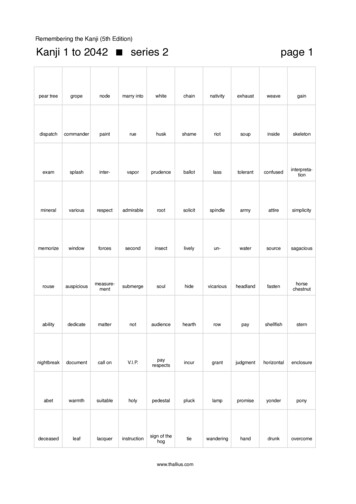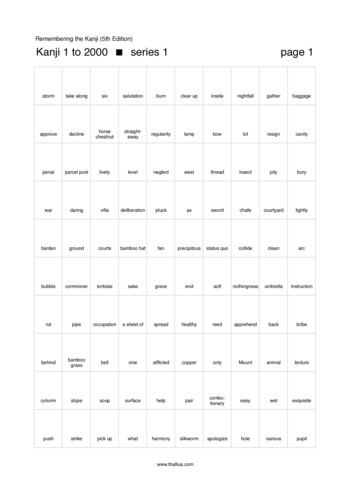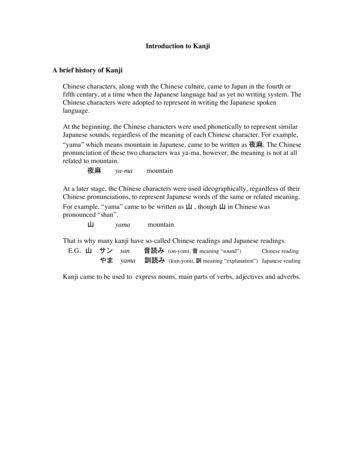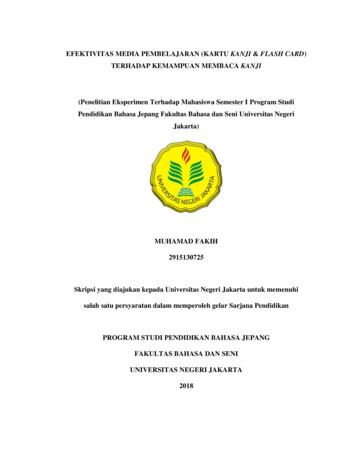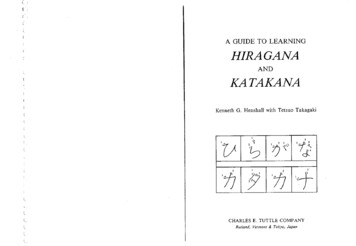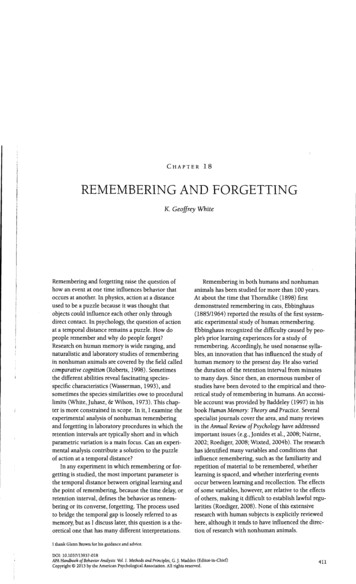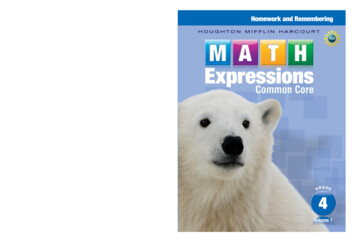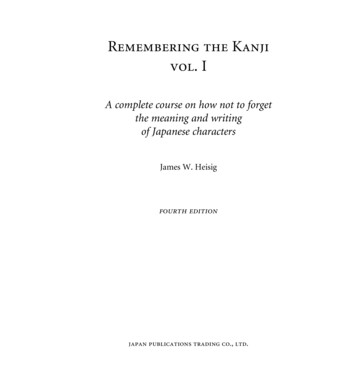
Transcription
Remembering the Kanjivol. IA complete course on how not to forgetthe meaning and writingof Japanese charactersJames W. Heisigfourth editionjapan publications trading co., ltd.
1977 by James W. HeisigAll rights reserved, including the right to reproduce this book or portionsthereof in any form without the written permission of the publisher.Published by Japan Publications Trading Co., Ltd.1–2–1 Sarugaku-chõ, Chiyoda-ku, Tokyo, 101–0064 JapanFirst edition: 1977Second edition: 1985Third edition, First printing: July 1986Fifteenth printing: November 1999Fourth edition, First printing: September 2001Distributors:united states: Kodansha America, Inc. throughOxford University Press, 198 Madison Avenue, New York, N. Y. 10016canada: Fitzhenry & Whiteside Ltd., 195 Allstate Parkway, Markham,Ontario l3r 4t8united kingdom and europe: Premier Book Marketing Ltd.,Clarendon House, 52 Cornmarket Street, Oxford ox1 3hj, Englandaustralia and new zealand: Bookwise International, 54 Crittenden Road,Findon, South Australia 5023, Australiaasia and japan: Japan Publications Trading Co., Ltd.,1–2–1 Sarugaku-chõ, Chiyoda-ku, Tokyo, 101–0064 Japan0 9 8 7 6 5 4 3 2 1isbn 4-88996-075-9Printed in Japan
ContentsIntroduction. . . . . . . . . . . . . . . . . . . . . . . . 1Note to the 4th Edition . . . . . . . . . . . . . . . . . . . . 8part one: Stories (Lessons 1–12). . . . . . . . . . . . . 13part two: Plots (Lessons 13–19) . . . . . . . . . . . . . 127part three: Elements (Lessons 20–56) . . . . . . . . . . 197Indexesi. Kanji . . . . . . . . . . . . . . . . . . . . . . . . 473ii. Primitive Elements. . . . . . . . . . . . . . . . . 491iii. Kanji Arranged in Order of Strokes. . . . . . . . . 495iv. Key Words and Primitive Meanings . . . . . . . . . . 505
IntroductionThe aim of this book is to provide the student of Japanese with a simplemethod for correlating the writing and the meaning of Japanese characters insuch a way as to make them both easy to remember. It is intended not only forthe beginner, but also for the more advanced student looking for some reliefto the constant frustration of forgetting how to write the kanji and some wayto systematize what he or she already knows. By showing how to break downthe complexities of the Japanese writing system into its basic elements and suggesting ways to reconstruct meanings from those elements, the method offersa new perspective from which to learn the kanji.There are, of course, many things that the pages of this book will not do foryou. You will read nothing about how kanji combine to form compounds. Noris anything said about the various ways to pronounce the characters. Furthermore, all questions of grammatical usage have been omitted. These are all matters that need specialized treatment in their own right. Meantime, remembering the meaning and the writing of the kanji—perhaps the single most dif³cultbarrier to learning Japanese—can be greatly simpli³ed if the two are isolatedand studied apart from everything else.What makes forgetting the kanji so natural is their lack of connection withnormal patterns of visual memory. We are used to hills and roads, to the facesof people and the skylines of cities, to µowers, animals, and the phenomena ofnature. And while only a fraction of what we see is readily recalled, we arecon³dent that, given proper attention, anything we choose to remember, wecan. That con³dence is lacking in the world of the kanji. The closest approximation to the kind of memory patterns required by the kanji is to be seen inthe various alphabets and number-systems we know. The difference is thatwhile these symbols are very few and often sound-related, the kanji number inthe thousands and have no consistent phonetic value. Nonetheless, traditionalmethods for learning the characters have been the same as those for learningalphabets: drill the shapes one by one, again and again, year after year. Whatever ascetical value there is in such an exercise, the more ef³cient way wouldbe to relate the characters to something other than their sounds in the ³rstplace, and so to break ties with the visual memory we rely on for learning ouralphabets.
2introductionThe origins of the Japanese writing system can be traced back to ancientChina and the eighteenth century before the Christian era. In the form inwhich we ³nd Chinese writing codi³ed some 1,000 years later, it was made uplargely of pictographic, detailed glyphs. These were further transformed andstylized down through the centuries, so that by the time the Japanese wereintroduced to the kanji by Buddhist monks from Korea and started experimenting with ways to adapt the Chinese writing system to their own language(about the fourth to seventh centuries of our era), they were already dealingwith far more ideographic and abstract forms. The Japanese made their owncontributions and changes in time, as was to be expected. And like every modern Oriental culture that uses the kanji, they continue to do so, though nowmore in matters of usage than form.So fascinating is this story that many have encouraged the study of etymology as a way to remember the kanji. Unfortunately, the student quickly learnsthe many disadvantages of such an approach. As charming as it is to see theancient drawing of a woman etched behind its respective kanji, or to discoverthe rudimentary form of a hand or a tree or a house, when the character itselfis removed, the clear visual memory of the familiar object is precious little helpfor recalling how to write it. Proper etymological studies are most helpful afterone has learned the general-use kanji. Before that, they only add to one’s memory problems. We need a still more radical departure from visual memory.Let me paint the impasse in another, more graphic, way. Picture yourselfholding a kaleidoscope up to the light as still as possible, trying to ³x in memory the particular pattern that the play of light and mirrors and colored stoneshas created. Chances are you have such an untrained memory for such thingsthat it will take some time; but let us suppose that you succeed after ten or³fteen minutes. You close your eyes, trace the pattern in your head, and thencheck your image against the original pattern until you are sure you have itremembered. Then someone passes by and jars your elbow. The pattern is lost,and in its place a new jumble appears. Immediately your memory begins toscramble. You set the kaleidoscope aside, sit down, and try to draw what youhad just memorized, but to no avail. There is simply nothing left in memoryto grab hold of. The kanji are like that. One can sit at one’s desk and drill a halfdozen characters for an hour or two, only to discover on the morrow thatwhen something similar is seen, the former memory is erased or hopelesslyconfused by the new information.Now the odd thing is not that this occurs, but rather that, instead of openlyadmitting one’s distrust of purely visual memory, one accuses oneself of a poormemory or lack of discipline and keeps on following the same routine. Thus,by placing the blame on a poor visual memory, one overlooks the possibility of
introduction3another form of memory that could handle the task with relative ease: imaginative memory.By imaginative memory I mean the faculty to recall images created purelyin the mind, with no actual or remembered visual stimuli behind them. Whenwe recall our dreams we are using imaginative memory. The fact that we sometimes conµate what happened in waking life with what merely occurred in adream is an indication of how powerful those imaginative stimuli can be.While dreams may be broken up into familiar component parts, the composite whole is fantastical and yet capable of exerting the same force on perceptualmemory as an external stimulus. It is possible to use imagination in this wayalso in a waking state and harness its powers for assisting a visual memoryadmittedly ill-adapted for remembering the kanji.In other words, if we could discover a limited number of basic elements inthe characters and make a sort of alphabet out of them, assigning to each its ownimage, fusing them together to form other images, and so building up complextableaux in imagination, the impasse created by purely visual memory mightbe overcome. Such an imaginative alphabet would be every bit as rigorous as aphonetic one in restricting each basic element to one basic value; but its grammar would lack many of the controls of ordinary language and logic. It wouldbe like a kind of dream-world where anything at all might happen, and happendifferently in each mind. Visual memory would be used minimally, to build upthe alphabet. After that, one would be set loose to roam freely inside the magiclantern of imaginative patterns according to one’s own preferences.In fact, most students of the Japanese writing system do something similarfrom time to time, devising their own mnemonic aids but never developing anorganized approach to their use. At the same time, most of them would beembarrassed at the academic silliness of their own secret devices, feeling somehow that there is no way to re³ne the ridiculous ways their mind works. Yet ifit does work, then some such irreverence for scholarship and tradition seemsvery much in place. Indeed, shifting attention from why one forgets certainkanji to why one remembers others should offer motivation enough to undertake a more thorough attempt to systematize imaginative memory.The basic alphabet of the imaginative world hidden in the kanji we maycall, following traditional terminology, primitive elements (or simply primitives). These are not to be confused with the so-called “radicals” which formthe basis of etymological studies of sound and meaning, and now are used forthe lexical ordering of the characters. In fact, most of the radicals are themselves primitives, but the number of primitives is not restricted to the traditional list of radicals.The primitives, then, are the fundamental strokes and combinations ofstrokes from which all the characters are built up. Calligraphically speaking,
4introductionthere are only nine possible kinds of strokes in theory, seventeen in practice. Afew of these will be given primitive meanings; that is, they will serve as fundamental images. Simple combinations will yield new primitive meanings inturn, and so on as complex characters are built up. If these primitives are presented in orderly fashion, the taxonomy of the most complex characters isgreatly simpli³ed and no attempt need be made to memorize the primitivealphabet apart from actually using it.The number of primitives, as we are understanding the term, is a mootquestion. Traditional etymology counts some 224 of them. We shall draw uponthese freely, and also ground our primitive meanings in traditional etymological meanings, without making any particular note of the fact as we proceed.We shall also be departing from etymology to avoid the confusion caused bythe great number of similar meanings for differently shaped primitives. Wherever possible, then, the generic meaning of the primitives will be preserved,although there are cases in which we shall have to specify that meaning in a different way, or ignore it altogether, so as to root imaginative memory in familiar visual memories. Should the student later turn to etymological studies, theprocedure we have followed will become more transparent, and should notcause any obstacles to the learning of etymologies. The list of elements that wehave singled out as primitives proper (Index ii) is restricted to the followingfour classes: basic elements that are not kanji, kanji that appear as basic elements in other kanji with great frequency, kanji that change their meaningwhen they function as parts of other kanji, and kanji that change their shapewhen forming parts of other kanji. Any kanji that keeps both its form and itsmeaning and appears as part of another kanji functions as a primitive, whetheror not it occurs with enough frequency to draw attention to it as such.The 2,042 characters chosen for study in these pages (given in the order ofpresentation in Index i and arranged according to the number of strokes inIndex iii) include the basic 1,850 general-use kanji established as standard bythe Japanese Ministry of Education in 1946,1 roughly another 60 used chieµy inproper names, and a handful of characters that are convenient for use as primitive elements. Each kanji is assigned a key word that represents its basic meaning, or one of its basic meanings. The key words have been selected on the basisof how a given kanji is used in compounds and on the meaning it has on itsown. There is no repetition of key words, although many are nearly synonymous. In these cases, it is important to focus on the particular µavor that thatword enjoys in English, so as to evoke connotations distinct from similar keywords. To be sure, many of the characters carry a side range of connotationsIn 1981 an additional 95 characters were added to this list. They have been incorporatedinto later editions of this book.1
introduction5not present in their English equivalents, and vice versa; many even carry several ideas not able to be captured in a single English word. By simplifying themeanings through the use of key words, however, one becomes familiar with akanji and at least one of its principal meanings. The others can be added laterwith relative ease, in much the same way as one enriches one’s understandingof one’s native tongue by learning the full range of feelings and meaningsembraced by words already known.Once we have the primitive meanings and the key word relevant to a particular kanji (cataloged in Index iv), the task is to create a composite ideogram. Here is where fantasy and memory come into play. The aim is to shockthe mind’s eye, to disgust it, to enchant it, to tease it, or to entertain it in anyway possible so as to brand it with an image intimately associated with the keyword. That image in turn, inasmuch as it is composed of primitive meanings,will dictate precisely how the kanji is to be penned—stroke for stroke, jot forjot. Many characters, perhaps the majority of them, can be so remembered ona ³rst encounter, provided suf³cient time is taken to ³x the image. Others willneed to be reviewed by focusing on the association of key-word and primitiveelements. In this way, mere drill of visual memory is all but entirely eliminated.Since the goal is not simply to remember a certain number of kanji, but alsoto learn how to remember them (and others not included in this book), thecourse has been divided into three parts. Part one provides the full associative story for each character. By directing the reader’s attention, at least for thelength of time it takes to read the explanation and relate it to the written formof the kanji, most of the work is done for the student even as a feeling for themethod is acquired. In Part two, only the skeletal plots of the stories are presented, and the individual must work out his or her own details by drawing onpersonal memory and fantasy. Part three, which comprises the major portion of the course, provides only the key word and the primitive meanings,leaving the remainder of the process to the student.It will soon become apparent that the most critical factor is the order oflearning the kanji. The actual method is simplicity itself. Once more basic characters have been learned, their use as primitive elements for other kanji cansave a great deal of effort and enable one to review known characters at thesame time as one is learning new ones. Hence to approach this course haphazardly, jumping ahead to the later lessons before studying the earlier ones, willentail a considerable loss of ef³ciency. If one’s goal is to learn to write theentire list of general-use characters, then it seems best to learn them in theorder best suited to memory, not in order of frequency or according to theorder in which they are taught to Japanese children. Should the individualdecide to pursue some other course, however, the indexes should provide all
6introductionthe basic information for ³nding the appropriate frame and the primitivesreferred to in that frame.It may surprise the reader casually lea³ng through these pages not to ³nd asingle drawing or pictographic representation. This is fully consistent withwhat was said earlier about placing the stress on imaginative memory. For onething, pictographs are an unreliable way to remember all but very few kanji;and even in these cases, the pictograph should be discovered by the student bytoying with the forms, pen in hand, rather than given in one of its historicalgraphic forms. For another, the presentation of an image actually inhibitsimagination and restricts it to the biases of the artist. This is as true for theillustrations in a child’s collection of fairy tales as it is for the various phenomena we shall encounter in the course of this book. The more original work theindividual does with an image, the easier will it be to remember a kanji.Before setting out on the course plotted in the following pages, attentionshould be drawn to a few ³nal points. In the ³rst place, one must be warnedabout setting out too quickly. It should not be assumed that because the ³rstcharacters are so elementary, they can be skipped over hastily. The methodpresented here needs to be learned step by step, lest one ³nd oneself forcedlater to retreat to the ³rst stages and start over; 20 or 25 characters per daywould not be excessive for someone who has only a couple of hours to give tostudy. If one were to study them full-time, there is no reason why the entirecourse could not be completed successfully in four to six weeks. By the timePart one has been traversed, the student should have discovered a rate ofprogress suitable to the time available.Second, the repeated advice given to study the characters with pad and pencil should be taken seriously. While simply remembering the characters doesnot, one will discover, demand that they be written, there is really no betterway to improve the aesthetic appearance of one’s writing and acquire a “natural feel” for the µow of the kanji than by writing them. The method will spareone the toil of writing the same character over and over in order to learn it, butit will not supply the µuency at writing that comes only with constant practice.If pen and paper are inconvenient, one can always make do with the palm ofthe hand, as the Japanese do. It provides a convenient square space for jottingon with one’s index ³nger when riding in a bus or walking down the street.Third, the kanji are best reviewed by beginning with the key word, progressing to the respective story, and then writing the character itself. Once onehas been able to perform these steps, reversing the order follows as a matter ofcourse. More will be said about this later in the book.In the fourth place, it is important to note that the best order for learningthe kanji is by no means the best order for remembering them. They need to berecalled when and where they are met, not in the sequence in which they are
introduction7presented here. For that purpose, recommendations are given in Lesson 5 fordesigning µash cards for random review.Finally, it seems worthwhile to give some brief thought to any ambitionsone might have about “mastering” the Japanese writing system. The idea arisesfrom, or at least is supported by, a certain bias about learning that comes fromoverexposure to schooling: the notion that language is a cluster of skills thatcan be rationally divided, systematically learned, and certi³ed by testing. Thekanji, together with the wider structure of Japanese—and indeed of any language for that matter—resolutely refuse to be mastered in this fashion. Therational order brought to the kanji in this book is only intended as an aid toget you close enough to the characters to befriend them, let them surprise you,inspire you, enlighten you, resist you, and seduce you. But they cannot be mastered without a full understanding of their long and complex history and aninsight into the secret of their unpredictable vitality—all of which is far toomuch for a single mind to bring to the tip of a single pen.That having been said, the goal of this book is still to attain native pro³ciency in writing the Japanese characters and associating their meanings withtheir forms. If the logical systematization and the playful irreverence containedin the pages that follow can help spare even a few of those who pick the bookup the grave error of deciding to pursue their study of the Japanese languagewithout aspiring to such pro³ciency, the efforts that went into it will havemore than received their reward.Kamakura, Japan10 February 1977
Note to the 4th EditionIn preparing a new layout and typesetting of this fourth edition, I was temptedto rethink many of the key words and primitive meanings, and to adjust thestories accordingly. After careful consideration and review of the hundreds ofletters I have received from students all over the world, as well as the changesthat were introduced in the French and Spanish versions of the book,2 I havedecided to let it stand as it is with only a few exceptions.There are, however, two related questions that come up with enough frequency to merit further comment at the outset: the use of this book in connection with formal courses of Japanese and the matter of pronunciation or“readings” of the kanji.The reader will not have to ³nish more than a few lessons to realize that thisbook was designed for self-learning. What may not be so apparent is that usingit to supplement the study of kanji in the classroom or to review for examinationshas an adverse inµuence on the learning process. The more you try to combinethe study of the written kanji through the method outlined in these pages withtraditional study of the kanji, the less good this book will do you. I know of noexceptions.Virtually all teachers of Japanese, native and foreign, would agree with methat learning to write the kanji with native pro³ciency is the greatest singleobstacle to the foreign adult approaching Japanese—indeed so great as to bepresumed insurmountable. After all, if even well-educated Japanese study thecharacters formally for nine years, use them daily, and yet frequently havetrouble remembering how to reproduce them, much more than Englishspeaking people have with the infamous spelling of their mother tongue, is itnot unrealistic to expect that even with the best of intentions and study methods those not raised with the kanji from their youth should manage the feat?Such an attitude may never actually be spoken openly by a teacher standingbefore a class, but as long as the teacher believes it, it readily becomes a selfThe French adaptation was prepared by Yves Maniette under the title Les kanji dans latête: Apprendre à ne pas oublier le sens et l’écriture des caractères japonais (Gramagraf SCCL,1998). The Spanish version, prepared in collaboration with Marc Bernabé and VerònicaCalafell, is Kanji para recordar: Curso mnemotécnico para el aprendizaje de la escritura y elsigni³cado de los caracteres japoneses (Barcelona: Editorial Herder, 2001).2
note to the 4th edition9ful³lling prophecy. This attitude is then transmitted to the student by placinggreater emphasis on the supposedly simpler and more reasonable skills oflearning to speak and read the language. In fact, as this book seeks to demonstrate, nothing could be further from the truth.To begin with, the writing of the kanji is the most completely rational partof the language. Over the centuries, the writing of the kanji has been simpli³edmany times, always with rational principles in mind. Aside from the Koreanhangul, there may be no writing system in the world as logically structured asthe Sino-Japanese characters are. The problem is that the usefulness of thisinner logic has not found its way into learning the kanji. On the contrary, it hasbeen systematically ignored. Those who have passed through the Japaneseschool system tend to draw on their own experience when they teach othershow to write. Having begun as small children in whom the powers of abstraction are relatively undeveloped and for whom constant repetition is the onlyworkable method, they are not likely ever to have considered reorganizingtheir pedagogy to take advantage of the older student’s facility with generalizedprinciples.So great is this neglect that I would have to say that I have never met aJapanese teacher who can claim to have taught a foreign adult to write the basicgeneral-use kanji that all high-school graduates in Japan know. Never. Norhave I ever met a foreign adult who would claim to have learned to write at thislevel from a native Japanese teacher. I see no reason to assume that the Japanese are better suited to teach writing because it is, after all, their language.Given the rational nature of the kanji, precisely the opposite is the case: theJapanese teacher is an impediment to learning to associate the meanings of thekanji with their written form. The obvious victim of the conventional methodsis the student, but on a subtler level the recon³rmation of unquestioned biasesalso victimizes the Japanese teachers themselves, the most devoted of whomare prematurely denied the dream of fully internationalizing their language.There are additional problems with using this book in connection withclassroom study. For one thing, as explained earlier in the Introduction, theef³ciency of the study of the kanji is directly related to the order in which theyare learned. Formal courses introduce kanji according to different principlesthat have nothing to do with the writing. More often than not, the order inwhich Japan’s Ministry of Education has determined children should learn thekanji from primary through middle school, is the main guide. Obviously,learning the writing is far more important than being certi³ed to have passedsome course or other. And just as obviously, one needs to know all the generaluse kanji for them to be of any use for the literate adult. When it comes toreading basic materials, such as newspapers, it is little consolation to know halfor even three-quarters of them. The crucial question for pedagogy, therefore,
10note to the 4th editionis not what is the best way to qualify at some intermediate level of pro³ciency,but simply how to learn all the kanji in the most ef³cient and reliable mannerpossible. For this, the traditional “levels” of kanji pro³ciency are simply irrelevant. The answer, I am convinced, lies in self-study, following an order basedon learning all the kanji.I do not myself know of any teacher of Japanese who has attempted to usethis book in a classroom setting. My suspicion is that they would soon abandon the idea. The book is based on the idea that the writing of the kanji can belearned on its own and independently of any other aspect of the language. It isalso based on the idea that the pace of study is different from one individual toanother, and for each individual, from one week to the next. Organizing studyto the routines of group instruction runs counter to those ideas.This brings us to our second question. The reasons for isolating the writingof the kanji from their pronunciation follow more or less as a matter of coursefrom what has been said. The reading and writing of the characters are taughtsimultaneously on the grounds that one is useless without the other. This onlybegs the basic question of why they could not better, and more quickly, betaught one after the other, concentrating on what is for the foreigner the simpler task, writing, and later turning to the more complicated, the reading.One has only to look at the progress of non-Japanese raised with kanji tosee the logic of the approach. When Chinese adult students come to the studyof Japanese, they already know what the kanji mean and how to write them.They have only to learn how to read them. The progress they make in comparison with their Western counterparts is usually attributed to their being“Oriental.” In fact, Chinese grammar and pronunciation have about as muchto do with Japanese as English does. It is their knowledge of the meaning andwriting of the kanji that gives the Chinese the decisive edge. My idea was simply to learn from this common experience and give the kanji an English reading. Having learned to write the kanji in this way—which, I repeat, is the mostlogical and rational part of the study of Japanese—one is in a much better position to concentrate on the often irrational and unprincipled problem of learning to pronounce them.In a word, it is hard to imagine a less ef³cient way of learning the readingand writing of the kanji than to study them simultaneously. And yet this is themethod that all Japanese textbooks and courses follow. The bias is too deeplyingrained to be rooted out by anything but experience to the contrary.Many of these ideas and impressions, let it be said, only developed after Ihad myself learned the kanji and published the ³rst edition of this book. At thetime I was convinced that pro³ciency in writing the kanji could be attained infour to six weeks if one were to make a full-time job of it. Of course, the claimraised more eyebrows than hopes among teachers with far more experience
note to the 4th edition11than I had. Still, my own experience with studying the kanji and the relativelysmall number of individuals I have directed in the methods of this book, bearsthat estimate out, and I do not hesitate to repeat it here.A word about how the book came to be written. I began my study of thekanji one month after coming to Japan with absolutely no previous knowledgeof the language. Because travels through Asia had delayed my arrival by severalweeks, I took up residence at a language school in Kamakura and began studying on my own without enrolling in the course alre
ing the meaning and the writing of the kanji—perhaps the single most dif³cult barrier to learning Japanese—can be greatly simpli³ed if the two are isolated and studied apart from everything else. What makes forgetting the kanji so natural is their lack of connection with normal patterns of visual memory.

